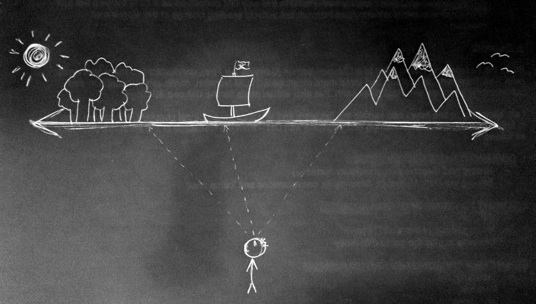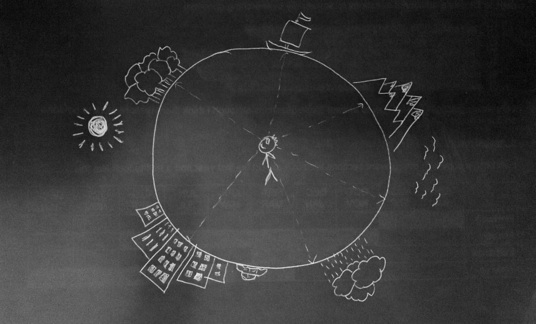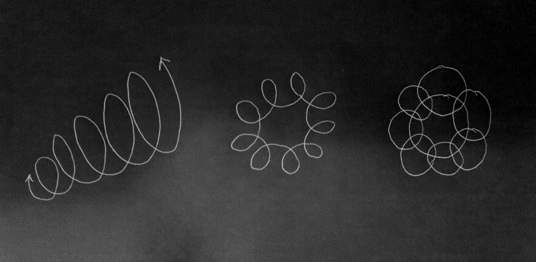REFIGURATIONS
The circle and the line
The horizon runs as an oblique, yet distinct, line across the landscape separating sky from earth and visible from unseen. It holds the particularity and uniqueness of each place, defines the limit of the world. Observing the horizon across a plane scenery like the ocean or flatlands, it draws a straight line so wide it appears without end. It is a magnet for the gaze, pulling in the attention wherever there is clear view. Unable to hold either beginning or end within our field of view, the horizon suggests an interminable arrow shooting right across the cosmos, separating below and above. This illusory line is immense and timeless. It has become firmly embedded in a diversity of human imaginaries, delineating the heavens, presenting a mythical image of the yonder, begetting dreamings, adventures and fears.
As an edgeland and a metaphor, the horizon is both compelling and ambiguous.

A cursory view of the horizon suggests a certain flatness of the earth and can produce elaborate fatamorganas of the imagination. The imagined boundaries between above and below, Heaven & Hell, seem to have a material foundation when we observe it inattentively. The horizon then becomes the physical embodiment of a binary worldview which sees in terms of division between sharply bounded categories, physical and metaphorical. This is a way of seeing which works in terms of polarity: identity is defined in terms of what something or someone is not. Here, Heaven is clearly a separate sphere, an otherworld which exists outside the confines of earthly reality. And so on. The horizon-as-line is a recurring metaphor in our recent cultural history and it is not difficult to see how this way of seeing closely aligns with visions of the earth as flat, foreign lands as terra incognita, and god as Skylord.
However, at a closer look the horizon refuses to submit to this perspective. In really flat places, the earth's curvature can be sensed out of the corner of the eye. Taking a small step sideways, the supposed line continues beyond the bounds of our view, it turns back on itself and as we slowly trace its course we end up turning around ourselves, drawing a circle with our gaze. It becomes obvious that the line, real as it appears, describes a circle. That the circle appears as a line. (This points to the nature of perception and of reality itself: always unfolding outwards in larger patterns while enfolding into elements containing the seeds of greater complexity.) In this view, the apparent polarity is relational: something or someone is such and such only because some other is not. Difference is a matter of degrees rather than of essence. The horizon-as-circle – insofar as it both explains the internal logic of horizon-as-line and points beyond it – is an organic and extended metaphor: it clarifies the context in which horizon-as-line works while it shows the limitations beyond which it produces incoherent assumptions.

Now, it is possible to say that the horizon-as-line points to the horizon-as-circle simply by following the line to it's logical conclusion (anecdotally, there is a parallel here to Gödel's incompleteness theorems). But translating perceptual and experiential intuition into conscious insight is challenging. Making the shift from line to circle psychologically is by no means easy: it involves contesting what has so far been taken for granted as real, as right, and as valid. The historical shift from an earth-centric to a heliocentric worldview shows the lived meaning of this: proclamations of heresy, defamation and burning at the stake. The bottom line is that the horizon-as-line was (and is) an unfaltering belief propped up by inattentive observation: just look at the horizon and there you see the line. It is extremely difficult to act rationally against one's beliefs; changing them is a longer journey of introspection and reflection. Nonetheless, with a bit of courage and an open discerning mind, it is not impossible. Following the circle round and round we see that it, too, is pointing to a larger pattern.
Because as we change location we see that every circle is different and all of them refuse to submit to the idea of one horizon-as-circle. The individuality of places, people and things show how ridiculous (and ideological) it is to treat the plurality of circles as if they conformed to the template of the platonic circle. The limits of horizon-as-circle is revealed by the wider context of horizon-as-plurality. In this way, the line is encompassed by the circle is encompassed by the many circles and all of a sudden the contours of a whole new range of shapes and figures emerge in an endless process which can continue as long as we care to keep exploring. A recurring pattern in this process shows that context determines meaning and that is is always possible to change or expand the context (and impossible to confine it). The meaning of horizon-as-line is only grasped when seen in the context of horizon-as-circle which is only properly understood in the context of horizon-as-plurality.

In the web of contexts that emerges, meaning is relational (and reality is too). This is not an esoteric philosophical point, this is… well, real, material and functional. In one sense, context is the 4th, fractal dimension of reality without which a whole range of cognitive, physical and evolutionary processes wouldn't be possible (see e.g. Dmitri Orlov's brilliant essay, In Praise of Anarchy, Part III, about Geoffrey West's research on the scaling of biological and social systems). We can use this insight to always situate our view and align our thinking with evolution itself. By accepting that our perspective is always encompassed and entangled in a web of contexts without which it would be meaningless, we also cultivate a healthy detachment from our ideas – there is then scope for thought to become proprioceptive in David Bohm's terminology (proprioception: attention to, and awareness of, the movement of thought). In turn, this is likely to help us move more fluently between one perspective and another without creating cognitive dissonance.
This way of seeing or style of thinking is only possible once the linear, dualistic and reductive perspective of horizon-as-line is enveloped by the horizon-as-circle. And it is in no way given that the circle will not become a limiting perspective as well. Careful observation, continuous attention and reflection is needed throughout. And perhaps most importantly, there has to be a willingness, a certain kind of surrender, to accept the incompleteness, uncertainty and indefinity of the process. It will never be possible to achieve the grand, outside view: there is always a greater context which cannot be anticipated. That is the nature of it.
We can use these insights to begin practicing an attitude, perceptiveness and thinking that is similar in character to the unfolding of evolution itself.
These ideas are not new and they are not mine. I've just drawn pictures with them. To understand them I have to work through them, play with them, change them and apply them. That's the territory I am exploring and what this blog is for. Refigurations is concerned with how meaning emerges, the way it functions and how it affects our thoughts and actions. In this way, I hope to better understand the ways in which ways of thinking that expand and ameliorate our lifeworlds can arise from exploring the edges of habitual thought. It seems to me we live in a time where we either learn to move along with the flow of life or fossilise. Refiguring some of the metaphors and meanings we take for granted might open up new conceptual tools and paths to help navigate the unknown geography of the future.
The fact that you are reading these words suggest that you might be looking in a similar way or direction. If you have a way of bending (drawing, painting, writing, speaking, singing, dancing) the circles I'm creating into new shapes – and insist on grounding them in lived experience – I'm here, on the other end of the line, open to mutual refiguring and conversation for a little while yet.
Thursday, 7 November 2013

Refiguring on Tumblr




